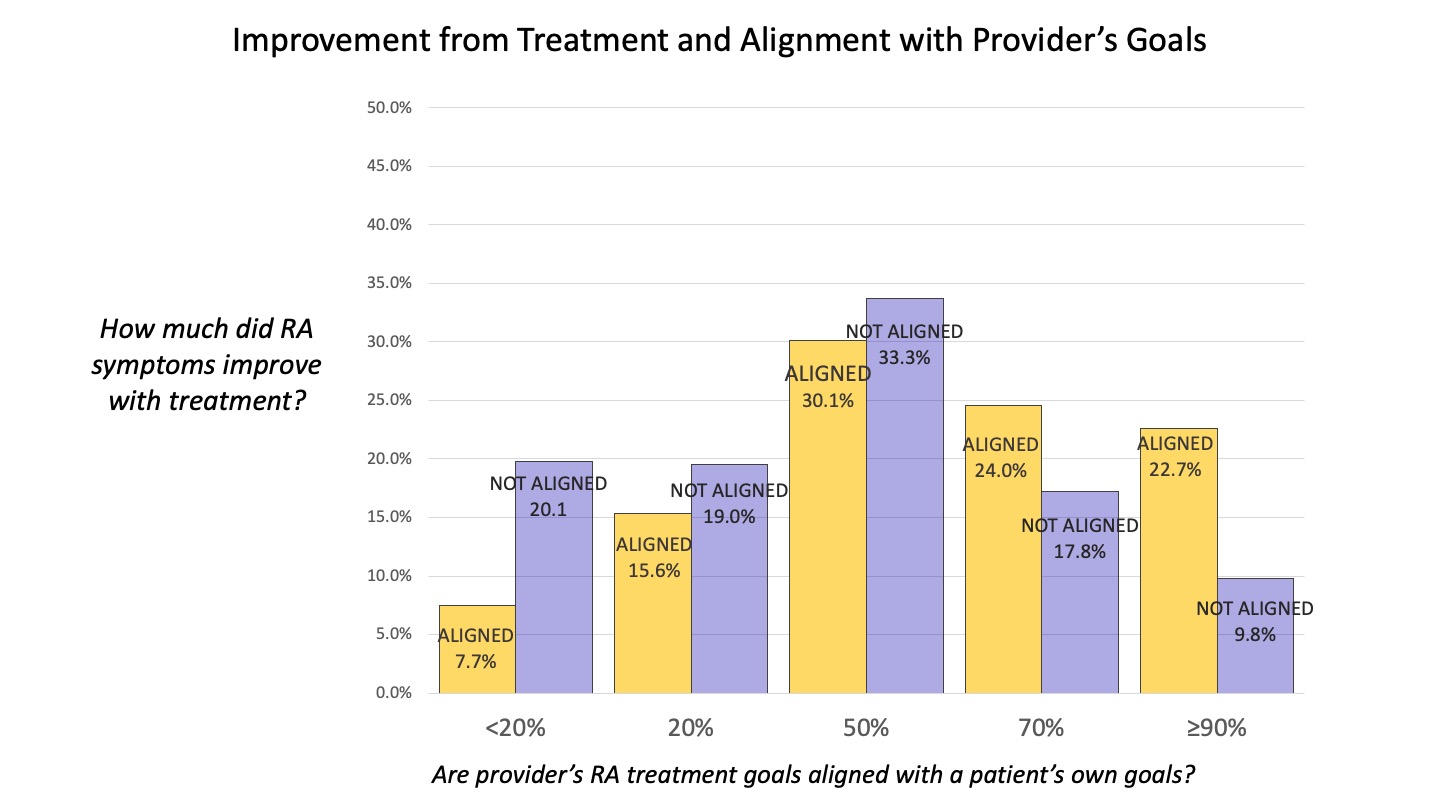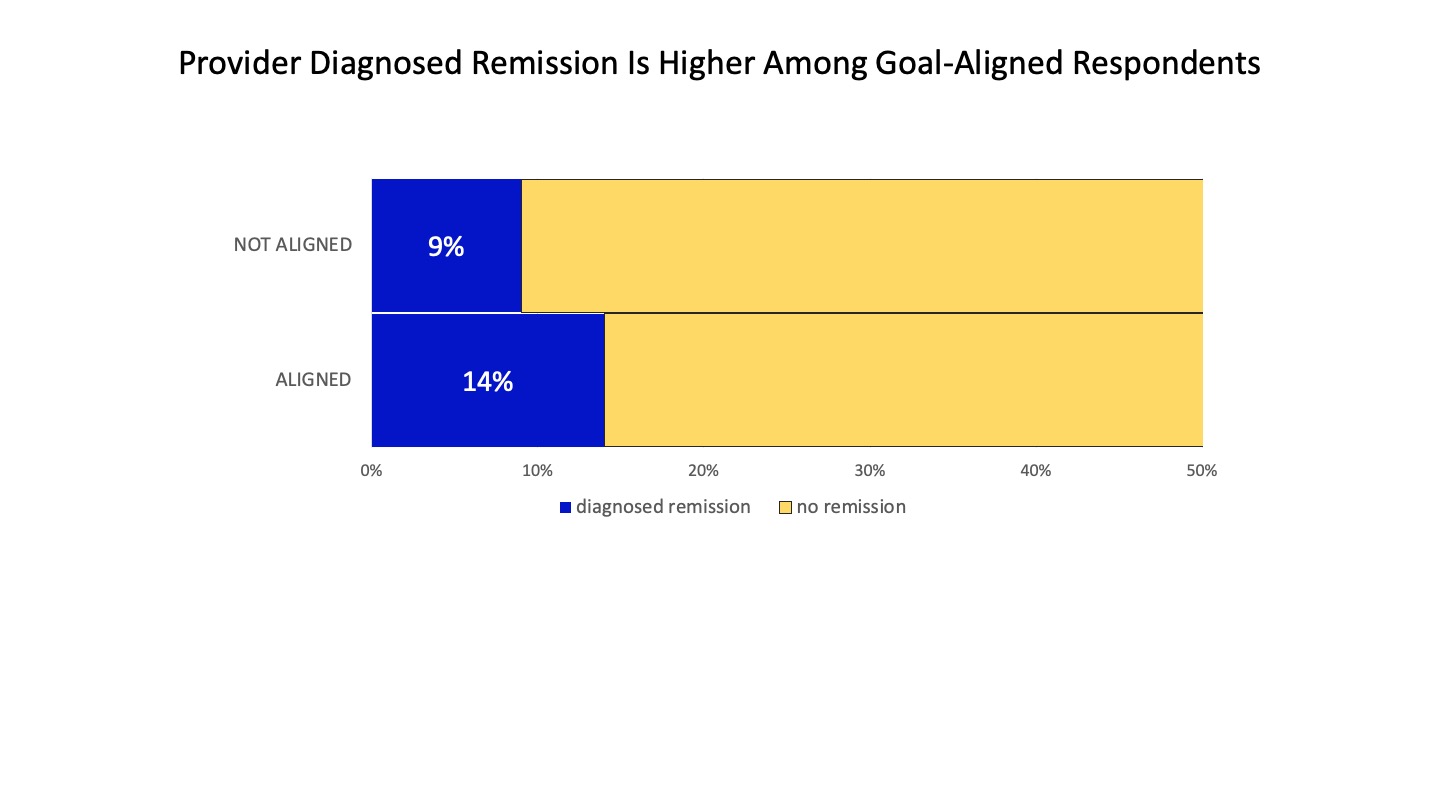Back
Abstract Session
Session: Abstracts: Patient Outcomes, Preferences, and Attitudes: Patient Priorities and Preferences: Interventions and Transformation (2243–2247)
2246: Rheumatoid Arthritis Patient Discordance with Provider Treatment Goals Is Associated with Poorer RA Outcomes
Monday, November 14, 2022
5:15 PM – 5:25 PM Eastern Time
Location: Room 114 Nutter Theatre
- KO
Kelly O'Neill, BA
Rheumatoid Patient Foundation, Inc.
Winter Springs, FL, United States
Presenting Author(s)
Kelly O'Neill1, Pamela Sinicrope2, Cynthia Crowson3, Kathryne Marks4, Rachel Giblon5, Elena Myasoedova2 and John Davis2, 1Rheumatoid Patient Foundation, Winter Springs, FL, 2Mayo Clinic, Rochester, MN, 3Mayo Clinic, Eyota, MN, 4Brigham and Women's Hospital, Boston, MA, 5Mayo Clinic, Rochester, MN, Rochester, MN
Background/Purpose: We previously reported on themes in rheumatoid arthritis (RA) patients' treatment goals which associated with aspects of rheumatology care such as presence of a treatment plan or shared goal discussion as well as disease activity (DA) levels. Building on our previous reports, we aimed to gain insight to the nature of the discordance between patient and provider goals and their association to outcomes.
Methods: An anonymous online questionnaire was presented in 2019 on a secure survey system. U.S. residents ≥18 years of age with a self-reported RA diagnosis by a medical professional responded to questions on demographics, DA, DMARD history, improvement from treatment, and RA treatment goals. Participants were asked how their providers' RA treatment goals differed from their own. Responses were assessed and coded thematically by a team using qualitative content analysis to identify reasons their goals differed from their providers'. Responses were also coded for strong emotion, poor communication, and difference in outcome expectation (high or low). Relationships between patient outcomes and discordance with provider treatment goals were assessed using Chi-square tests for categorical variables and Kruskal-Wallis tests for continuous variables.
Results: The survey was completed by 907 RA patients (90% women) with 58 (11) yrs mean (SD) age and 11 (10) yrs since diagnosis. 82% (n=740) responded to the question "How do you think your healthcare provider's treatment goals differ from your own goals?". Of those, 53% (n=392) did not differ ("aligned" with their providers' goals). Self-reported DA was moderate to severe in 67% of respondents whose goals were aligned compared to 81% among those non-aligned, with self-assessed remission rates of 7% and 2%, respectively (p=< 0.001). Provider diagnosed remission and self-reported treatment improvement of 50% or more was also higher among aligned respondents than non-aligned; 14% vs 9%, p=0.034 and 77% vs 61%, p< 0.001, respectively. Additionally, aligned responders were more likely to be in good to very good health (47% vs 33%, p< 0.001).
Conclusion: This survey explored patient discordance with providers' treatment goals and how that discordance associates with treatment outcomes like remission, improvement from treatment, and current level of DA. Further research should seek greater insight to RA patient treatment goals and discordance with providers' goals to explore their significance in RA outcomes.
.jpg) RA treatment outcomes by whether or not patients align with providers' treatment goals.
RA treatment outcomes by whether or not patients align with providers' treatment goals.
 Levels of symptom improvement with treatment are divided by those who considered their goals aligned with their provider’s vs those who did not consider their goals aligned. Greater symptom improvement is more associated with aligned goals while lower symptom improvement is associated with not aligned goals.
Levels of symptom improvement with treatment are divided by those who considered their goals aligned with their provider’s vs those who did not consider their goals aligned. Greater symptom improvement is more associated with aligned goals while lower symptom improvement is associated with not aligned goals.
 Those who considered their goals aligned with their provider’s and those who did not consider their goals aligned are divided by those who have been diagnosed as being in remission vs not. Respondents in the aligned category were more likely to have been diagnosed with remission.
Those who considered their goals aligned with their provider’s and those who did not consider their goals aligned are divided by those who have been diagnosed as being in remission vs not. Respondents in the aligned category were more likely to have been diagnosed with remission.
Disclosures: K. O'Neill, None; P. Sinicrope, None; C. Crowson, None; K. Marks, None; R. Giblon, None; E. Myasoedova, None; J. Davis, Pfizer.
Background/Purpose: We previously reported on themes in rheumatoid arthritis (RA) patients' treatment goals which associated with aspects of rheumatology care such as presence of a treatment plan or shared goal discussion as well as disease activity (DA) levels. Building on our previous reports, we aimed to gain insight to the nature of the discordance between patient and provider goals and their association to outcomes.
Methods: An anonymous online questionnaire was presented in 2019 on a secure survey system. U.S. residents ≥18 years of age with a self-reported RA diagnosis by a medical professional responded to questions on demographics, DA, DMARD history, improvement from treatment, and RA treatment goals. Participants were asked how their providers' RA treatment goals differed from their own. Responses were assessed and coded thematically by a team using qualitative content analysis to identify reasons their goals differed from their providers'. Responses were also coded for strong emotion, poor communication, and difference in outcome expectation (high or low). Relationships between patient outcomes and discordance with provider treatment goals were assessed using Chi-square tests for categorical variables and Kruskal-Wallis tests for continuous variables.
Results: The survey was completed by 907 RA patients (90% women) with 58 (11) yrs mean (SD) age and 11 (10) yrs since diagnosis. 82% (n=740) responded to the question "How do you think your healthcare provider's treatment goals differ from your own goals?". Of those, 53% (n=392) did not differ ("aligned" with their providers' goals). Self-reported DA was moderate to severe in 67% of respondents whose goals were aligned compared to 81% among those non-aligned, with self-assessed remission rates of 7% and 2%, respectively (p=< 0.001). Provider diagnosed remission and self-reported treatment improvement of 50% or more was also higher among aligned respondents than non-aligned; 14% vs 9%, p=0.034 and 77% vs 61%, p< 0.001, respectively. Additionally, aligned responders were more likely to be in good to very good health (47% vs 33%, p< 0.001).
Conclusion: This survey explored patient discordance with providers' treatment goals and how that discordance associates with treatment outcomes like remission, improvement from treatment, and current level of DA. Further research should seek greater insight to RA patient treatment goals and discordance with providers' goals to explore their significance in RA outcomes.
.jpg) RA treatment outcomes by whether or not patients align with providers' treatment goals.
RA treatment outcomes by whether or not patients align with providers' treatment goals. Levels of symptom improvement with treatment are divided by those who considered their goals aligned with their provider’s vs those who did not consider their goals aligned. Greater symptom improvement is more associated with aligned goals while lower symptom improvement is associated with not aligned goals.
Levels of symptom improvement with treatment are divided by those who considered their goals aligned with their provider’s vs those who did not consider their goals aligned. Greater symptom improvement is more associated with aligned goals while lower symptom improvement is associated with not aligned goals. Those who considered their goals aligned with their provider’s and those who did not consider their goals aligned are divided by those who have been diagnosed as being in remission vs not. Respondents in the aligned category were more likely to have been diagnosed with remission.
Those who considered their goals aligned with their provider’s and those who did not consider their goals aligned are divided by those who have been diagnosed as being in remission vs not. Respondents in the aligned category were more likely to have been diagnosed with remission.Disclosures: K. O'Neill, None; P. Sinicrope, None; C. Crowson, None; K. Marks, None; R. Giblon, None; E. Myasoedova, None; J. Davis, Pfizer.

